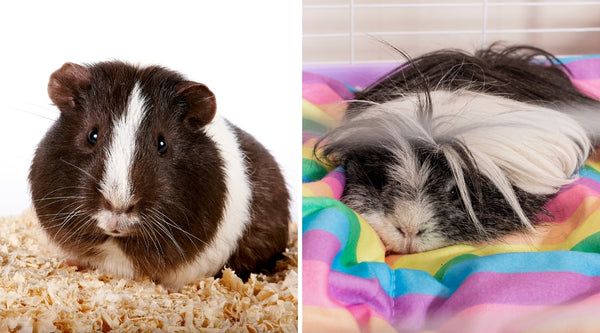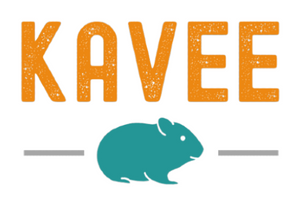Guinea pig care has changed loads over the years! Here’s how.

As much as I love my fur babies, Ruby and Magic, there will always be two other very special piggies with a place in my heart.
Daisy and Twinkle were the guinea pigs my sister and I were given as children waaay back in the 1980s (and no, I’m not telling you my age).
We got them as babies - two adorable little scraps of fluff - and I’ll never forget my first cuddle with them or the years of joy they gave our family.
They were the cutest, cuddliest pets we could have hoped for, which is why I wanted my own kids to experience the joy of caring for guinea pigs too.
But the truth is that the way we look after our furry pals in 2022 is quite different to how my beloved 1980s piggies lived back then.
Here are the main differences between ‘then’ and ‘now’.
DIFFERENCE #1: INDOOR/OUTDOOR

Years ago, many pet owners kept their guinea pigs in outdoor hutches and some still do today. However it’s important to know that these days, animal welfare organizations advise that guinea pigs don’t live permanently outdoors.
Being sensitive little creatures, piggies are susceptible to respiratory diseases if they spend too long in chilly draughts. They also can’t cope with hot weather and may develop heat stroke if they’re left in sweltering temperatures for too long.
Back in the 1980s, our guinea pigs’ hutch was in a warm, dry, lit shed and they also had a large run on the lawn for dashing around and nibbling grass. We spent loads of time with them and they were happy little souls.
Fast forward to 2022 and we have our guinea pigs in their roomy and uber stylish C&C cage indoors, in a bright and airy room next to our kitchen.
Now I understand how lovely it is to have them in the house with us; how they enjoy interacting with us as a family.
It’s lovely to hear their little squeaks and excited wheeks whenever they hear the fridge door being swung open followed by the promising rustle of food packets. Increasing numbers of 21st century piggy parents are now choosing to keep their fur babies indoors.
Keeping your piggies indoors isn’t just beneficial for your piggies, it’s a lot of fun for you too!
DIFFERENCE #2: GUINEA PIG CAGE SIZE

This is the biggie - or, sadly, not so big if you look back at standard guinea pig cage sizes in the 1980s.
Cages sold back were much smaller then and unfortunately, many guinea pigs lived in cramped, uncomfortable conditions in years gone by.
Sadly, many guinea pigs are still living in those conditions today because some pet shops sell cages that are too small and not fit for purpose.
Kavee believes that the current minimum cage sizes set by animal welfare organizations aren’t large enough for active cavies.
Check out this table of minimum cage sizes. At Kavee, we feel strongly that the minimum floor space advised simply doesn’t give your piggies enough space or a decent quality of life.
|
Number of guinea pigs |
Minimum floor space |
Recommended floor space |
|
2 sows |
2x3 C&C = 8 ft2 |
2x4 C&C = 10 ft2 |
|
3 sows |
2x4 C&C = 10 ft2 |
2x5 C&C = 12ft2 |
|
2 boars |
2x4 C&C = 10 ft2 |
2x5 C&C = 12ft2 |
|
1 neutered boar & 2 sows |
2x4 C&C = 10 ft2 |
2x5 C&C = 12ft2 |
|
4 sows |
2x5 C&C = 12ft2 |
2x6 C&C = 14 ft2 |
With all this in mind, at Kavee, we advise that the kindest choice is to ignore the minimum size guidelines. Instead, go up a size (see the recommended cage size). In fact, go up as many sizes as you can….
It’s the 2022 way!
Pet shops don’t tend to sell cages that go much over the minimum cage sizes. Thankfully, though, there is a new solution for forward thinking piggy parents: C&C cages.
These ingenious 21st century cages offer space for piggies and flexibility for owners because the clever grid system allows you to alter and rework your cage whenever you feel the need.
So say no to old-fashioned cramped pet shop cages and embrace modern, spacious and flexible C&C cages instead, just as I have done for my own 21st century guinea pigs.
DIFFERENCE #3: GUINEA PIG OUTDOOR RUNS

In warmer months, our 1980s guinea pigs had a lovely life, dashing up and down their run on the lawn. It was lovely to see them munching grass and popcorning all over the place.
However, outdoor runs were more of a DIY thing back then and we used a chicken wire mesh secured by wooden stakes which kept them secure.
Well most of the time anyway...
We did have a few hairy moments when predators including next door’s cat - and also a fox - almost managed to break in. Then there was that time both piggies managed to sneak out from underneath the chicken wire mesh and legged it off across the lawn. After a few heart stopping minutes, the little adventurers were found hiding in a flowerbed.
If sturdier arrangements had been available back then, we would have snapped them up. Thankfully, nowadays you can buy nifty C&C outdoor runs and playpens. You can pop them up in your garden for playtime and then either leave standing for next time or remove them when your piggies go back inside (as already mentioned, animal welfare organizations advise against leaving guinea pigs outdoors all the time).
C&C outdoor runs and playpens are robust and have lids which mean that your piggies are better protected against predators. That said, you need to be careful when taking your beloved fluff balls outside. Never leave your piggies alone in the garden even when they’re in their run - they’re prey animals after all and need your protection from predators such as cats, foxes and birds of prey.
DIFFERENCE #4: GUINEA PIG BEDDING

Back in the day, guinea pig owners really only had one choice when it came to bedding for their piggies’ cages and that was wood shavings. Cheap and absorbent, shavings were the long accepted standard for guinea pig bedding. My own 1980s guinea pigs had shavings in their cage.
But there were cons such as shavings being messy and dusty, even if they’re labelled as ‘dust extracted’ - not great if anyone in your home suffers with allergies and also not ideal considering piggies are susceptible to respiratory infections. Also, some shavings contain nasty chemicals which are harmful for piggies.
Thankfully, things have moved on since then… Now, we have much more choice when it comes to choosing guinea pig bedding.
These days, piggy parents are swapping wood shavings for a different cage lining….fleece!
This highly absorbent man made fabric has clever ‘wicking’ properties, which means it can transport liquid away from the surface through to lower layers of the fabric.
Kavee fleece liners - made specifically to fit Kavee C&C cages - are constructed from two layers of fleece - a smooth surface layer on top and a thicker, fluffy layer of ‘sherpa fleece’ below. Pee is drawn into the padding, leaving the fleece liner surface dry and keeping piggies comfortable for days.
And there’s none of the mess or other down sides of old school wood shavings. Also, if you’re fashion conscious, you’ll love picking out your design of fleece. My own personal favorite - and the one lining my 21st century guinea pigs’ cage is the daisy fleece liner. So pretty.
WHAT HAS STAYED THE SAME?
Although the passing of time brings inevitable change to all aspects of life and has brought benefits to the world of guinea pig keeping, including more spacious cages, safer outdoor runs and playpens and a wider choice of bedding including absorbent, colourful fleece liners, there are also some things that will never ever change.
My 1980s guinea pigs loved eating crispy fresh lettuce leaves, hay and dandelions. Fast forward to 2022 and there’s no change there. Guinea pigs will surely love their dandelions and hay until the end of time.
Although our 1980s piggies were given to my sister and me as our very first pets, my parents fell in love with them too. Fast forward to 2022 and although Ruby and Magic are officially my children’s pets, I’m head over heels for them too and love our quiet, calm cuddles when the kids are at school!
My very first piggies loved scampering around their run - and these days, Ruby and Magic don’t stop bouncing around, especially at feeding time.
Let’s face it, no matter how many years drift by, there’s something else that won’t ever change when it comes to cavies. The joy of seeing your excited piggies dashing about and popcorning in fresh hay will surely never get old.







